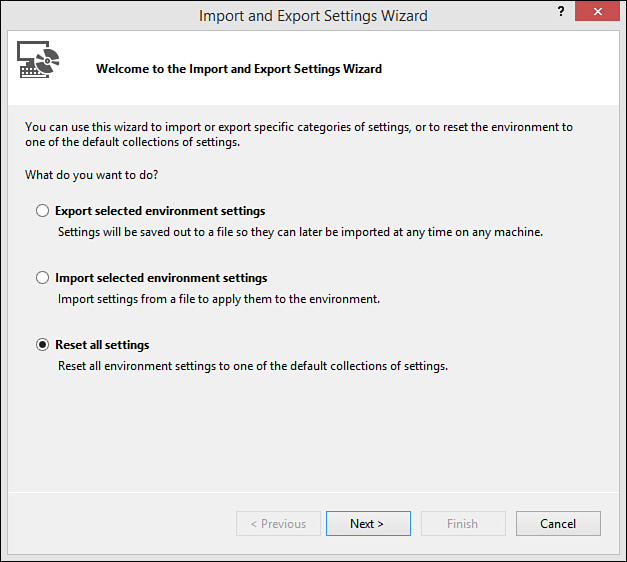Manually Import/Export and Change Default IDE Settings
You can also switch your full environment settings from one type of developer to another. The developer settings collections reset your IDE and related dialogs (such as New Project) to highlight items most relevant to a given developer type (such as Web, C#, or Visual Basic). Resetting your IDE default settings collection is useful if you do a lot of switching from one language to another or if you switch roles. For example, C# developers might use the C# development settings most of the time. They might then toggle to another collection of settings when switching to Visual Basic or developing a web-only application.
You manage your environment settings from the Tools menu’s Import and Export Settings option. Figure 2.6 shows the first screen in this wizard. This screen enables you to choose to execute a settings export, import, or total reset. First, we focus on resetting the IDE to one of the Visual Studio defaults (by choosing Reset all settings).
FIGURE 2.6 Use the Import and Export Settings Wizard to reset your settings back to the Visual Studio default options.
The next step in the Wizard when resetting your settings is an option to save any current settings. Figure 2.7 shows how you can store your current settings locally before resetting. This allows you to use the same tool to import this settings file back to your IDE if you need to use them again. You can use this same file to share these saved settings if needed.
The last step when resetting is to select a default collection of settings to import. Figure 2.8 shows the available collections from which to choose. These settings are based on language selection and development style.
The other two options in the wizard are used to export and import settings (see Figure 2.6). In both cases you select which settings you want to export and which you plan to import. For example, you might love the way a friend has configured her code editor in terms of font and contrasting colors, but you do not want all her other settings, such as her keyboard configurations. You can accomplish this by selecting to import only her code editor settings. Figure 2.9 provides a glimpse at the granular level to which you can manage your environment settings during import and export.
In Figure 2.9, note the warning icon next to the Import and Export Settings selection. Some settings may contain sensitive data (for instance, a folder path that includes domain information or your user name), and this icon flags those items that should be treated with care to avoid disclosing what might be confidential information.




